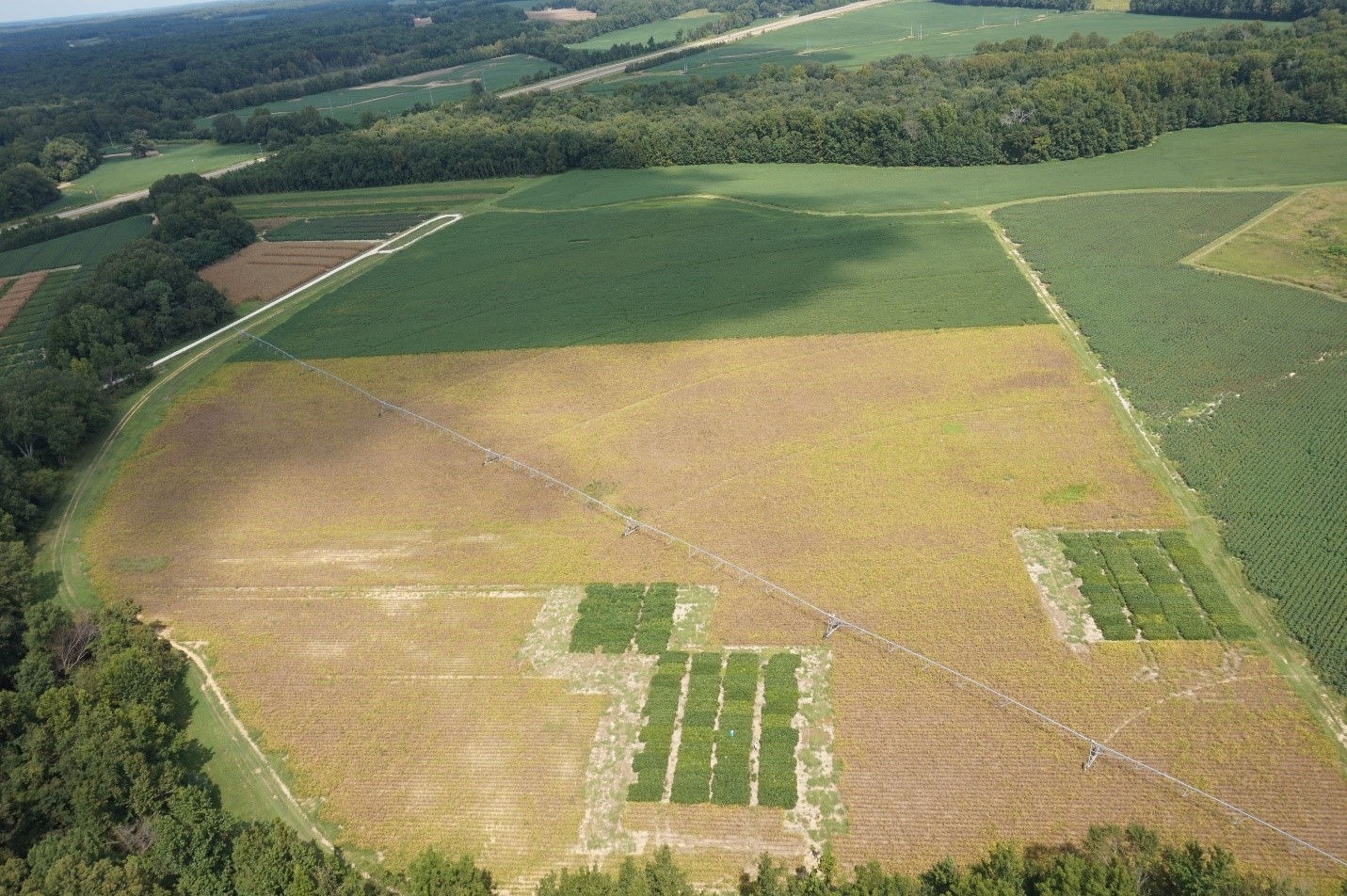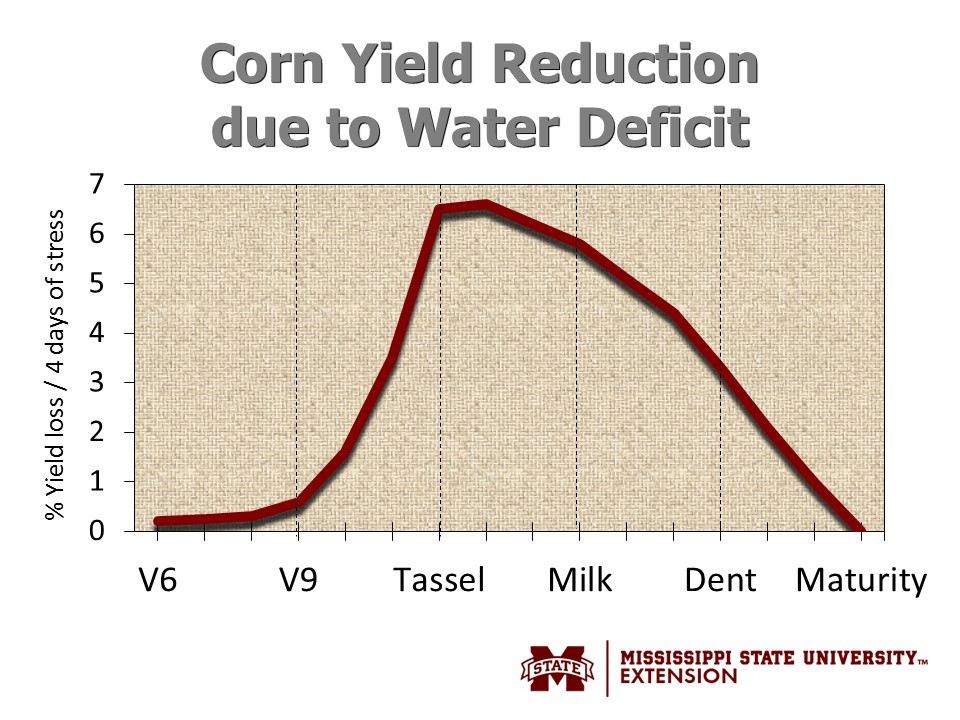 Photo credit: University of Tennessee Institute of Agriculture (UTIA), Shekoofa’s lab
Photo credit: University of Tennessee Institute of Agriculture (UTIA), Shekoofa’s lab
Irrigation timing: Corn & soybean
As we head into the second week of June, many growers are understandably concerned about potential yield loss due to drought stress. In this blog post our Extension Corn and Soybean Specialist, Dr. Jake McNeal and I have discussed irrigation strategies for both corn and soybean.
Understanding the relationship between crops and their environment is critical for effective irrigation management. Crop water use and demand varies as a function of growth stage and weather conditions. Furthermore, the capacity of a soil to hold and deliver water to plant roots (soil water–holding capacity) varies widely across different soil textures.
Also, we want to emphasis that there is a distinct physiological difference between heat stress and drought stress, especially in corn. Even in the presence of adequate soil water, corn leaves will often curl inward from the leaf margins during extended periods of high temperatures. Many refer to this as “pineapple leaves” or a “pineapple crop”. Furthermore, it is very difficult to discern between the two without utilizing a soil water sensor in your crop.
Corn-The Mid-South region of the U.S. receives sufficient annual rainfall to grow corn without irrigation in most years. However, irrigation is common in corn production because rainfall is not always distributed adequately throughout the growing season for the crop, especially during critical reproductive periods. Therefore, not all rainfall can be considered effective.
Corn water demand varies as a function of growth stage. It requires less water at early vegetative (seedling to V8) and late reproductive (R6) growth stages (Figure 1), while the peak water demand occurs during the period two weeks pre and post silking (R1). Soil water is rarely a yield-limiting factor during vegetative growth stages. In most years we receive a sufficient amount of rainfall during the early spring months to satisfy crop water demand until corn goes reproductive.
When observing vegetative wilting (pineapple leaves) in midday, we advise caution against making a decision to irrigate prior to checking your soil water sensors. It is very common to observe corn leaves rolling after a week or two without rainfall, particularly as the evaporative demand increases and air temperature climb into the 90’s. In much of Tennessee, this is the exact situation our corn crop is in right now. Our previous years of research along with similar studies from neighboring states using soil water sensors indicate that the amount of soil water in the top 6 – 8” of topsoil is adequate at this time of year.
Triggering irrigation without considering soil water content has the potential to negatively impact corn root development and therefore, crop productivity. Many nutrients essential to maximizing corn yield potential are immobile or somewhat immobile within the soil profile. This means that they do not “move”; rather, they are held by the soil and require physical contact with plant roots before they can be utilized. Even if it were possible to satisfy crop water demand in 6-8” of soil, it is nearly impossible to do so from a fertility standpoint.
From V13 to R1 (silking), the effect of drought stress on corn grain yield does becomes severe. Yield loss due to drought stress is greatest at silking, followed by the blister stage (R2). See Figure 1 (below) from Mississippi State University. The critical period for yield loss due to drought stress (Figure 1) follows corn water demand across growth stage (Figure 2).

Additionally, it is critical than we enter R1 with a fully charged soil profile. With corn, maybe more than any other crop, getting behind means staying behind. If we enter the reproductive period with a water-deficit stress in the soil, the majority of our irrigation systems would have to run 24 hrs. a day in order to meet crop water demand during this time.
This means transitioning from a conservative irrigation strategy during vegetative stages to a generous strategy during reproductive stages (read more about corn irrigation strategies here). Water use remains very high until we move past the dough stage (R4). Read more about when to irrigate corn here

Soybean- Water use in soybean is lowest (0.05 to 0.10“ per day) at germination and during seedling & vegetative growth stages. However, it increases to 0.20 to 0.30” per day from flowering through pod fill (R1 to R6.5) (Figure 3). In years with adequate rainfall, irrigation may only be needed when weather conditions are dry during peak demand times such as pod set and seed fill (R3 through R6). Read more here about Irrigating Soybean

Source: Adapted from “Soybean Growth Staging Guide” https://www.manitobapulse.ca/2015/03/soybean-staging-guide/
To help maintain adequate plant available water during dry periods or in sandy soils, irrigation during vegetative stages may be required to make sure we have adequate soil moisture when we enter R3. Much like in corn, we want to enter the reproductive period with a charged soil profile. This makes interpreting and relying on soil water sensors much easier as well. Read more here
Irrigation should be terminated by R6 to R6.5 or full seed stage (more than 50% of plants have touching seed in at least one of the top 4 nodes). This is the point when the seed easily separates from the protective pod wall membrane. At this point, the seed are no longer receiving water or nutrients from the plant. Dr. McClure’s research across three years at Milan suggests adding water beyond R6.5 will likely reduce yields.
Don’t hesitate to reach out to your local county office if you have any questions on irrigation strategies or on anything else relating to corn and soybeans over the next few months.

